BU VPN
BU campus resources are protected by a security firewall, which blocks access to many work resources from off campus. For users with a BU name and password though, a VPN connection can be used to identify yourself to the firewall and get access to those resources. If you have a work laptop you normally access your n: drive and other work services from, you can have the same access from home as you do on campus by installing and running the Forticlient VPN tool below. For those wishing to access their work desktop from home, you first need to install the Forticlient VPN tool below to authenticate to the firewall, and then follow these steps to use remote desktop to connect securely to your work desktop.
Forticlient Setup
Prerequisites (for version of FortiClient VPN 6.4)
- Windows Version – Windows 7, Windows 8.1, Windows 10 (32-bit and 64-bit for all versions)
- Mac Version – macOS High Sierra (version 10.13) or higher
Download FortiClient from https://www.fortinet.com/support/product-downloads
Scroll down the screen to the “FortiClient VPN” section, and choose the download for your operating system (Windows or MacOS). Ensure the program title is stated as “FortiClient VPN“, don’t download any other versions of FortiClient-named programs listed on the page.
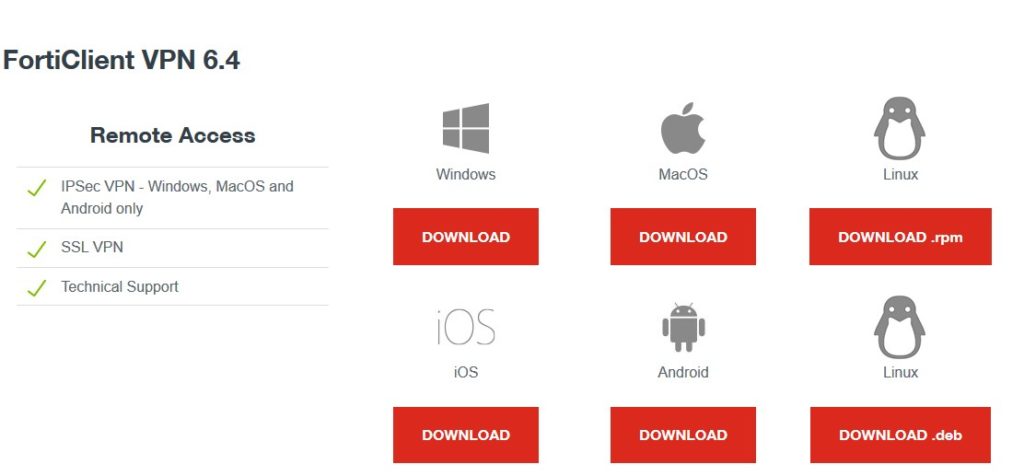
Save the download then install the program, clicking through the prompts until finished
The Forticlient website maybe overloaded from time to time. If you are unable to download the software you can download the software from our website. It is still preferred to download directly from Forticlient as they will have the most current version available to you.
Download for Windows/Mac/Linux
Open/Launch FortiClient:
For windows users, double click the FortiClient Shield icon on the desktop. ![]()
You can also access the program through the programs menu.
For mac users, an icon that looks like a gray and white shield should show towards the top right hand side of the screen, if you hover your mouse over it, it should show text indicating it is FortiClient. You can also look for FortiClient in the Launch Pad.
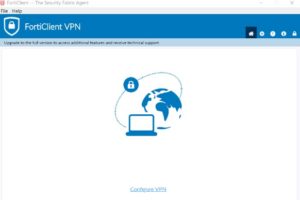
Accept the license agreement, and click “Configure VPN”
New VPN Connection
VPN: SSL-VPN
Connection Name: buvpn
Description: BUVPN
Remote Gateway: buvpn.brandonu.ca
Leave Customize port unchecked with port number 443
Client Certificate: None
Authentication: Prompt on Login
Click Save
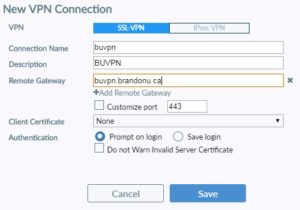
At the login screen type in your BU username and your BU password
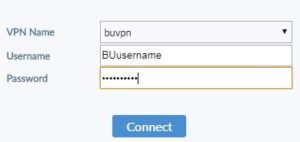
In the username field, type your bu username
In the password field, type your bu password
Click Connect
***if you have trouble connecting you can try adding bu-ad\ before your username (bu-ad\username)
Once connected, you will get a screen similar to the one below. You can minimize the screen while you are working.
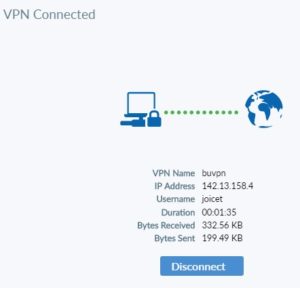
With FortiClient connected, you should be able to access network resources that require authentication, like SPSS (if you have it installed on your computer) or other sites like workforce.brandonu.ca
To Disconnect, click the Disconnect button
If the BUVPN client starts to cause problems like losing connection a lot:
- Shutdown and restart the computer
- Uninstall FortiClient reboot and reinstall FortiClient
- Run a disk cleanup utility like “Disk Cleanup” on Windows to remove temporary files created and left behind by FortiClient
There are some library resources that are not recommended to be accessed via the VPN. If you are having trouble accessing certain library resources please try accessing them without connecting the VPN.
